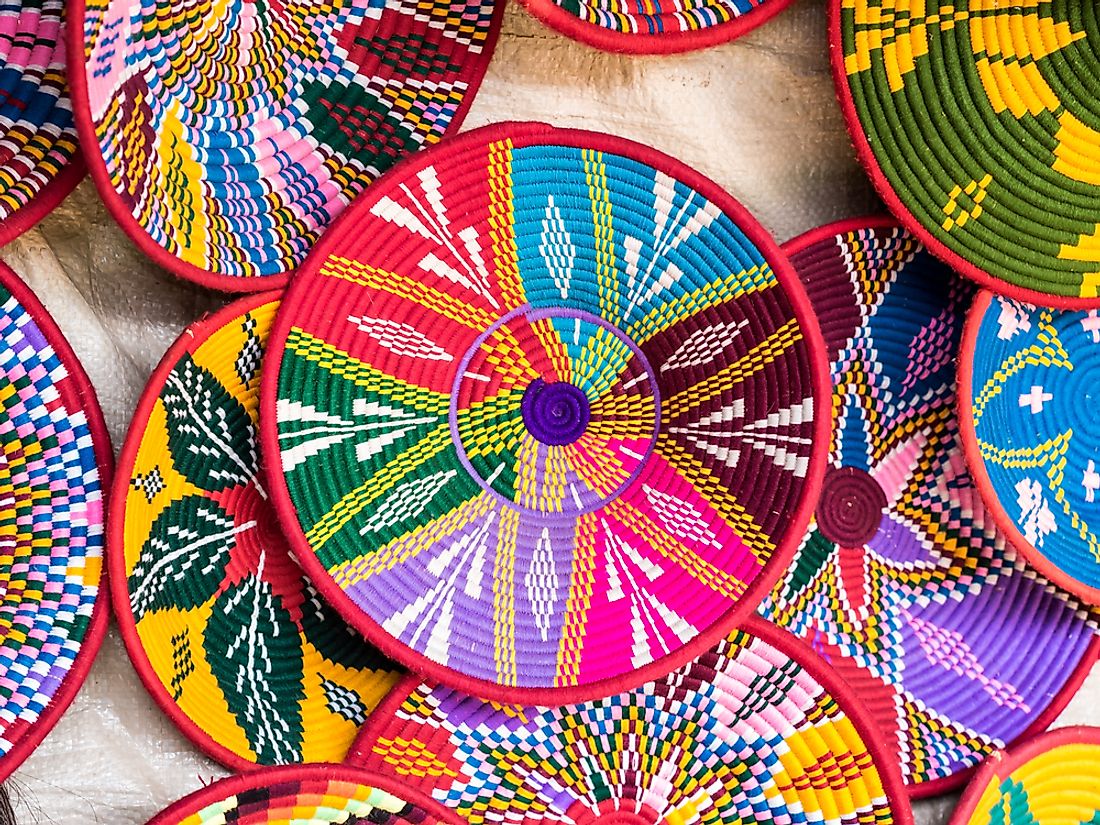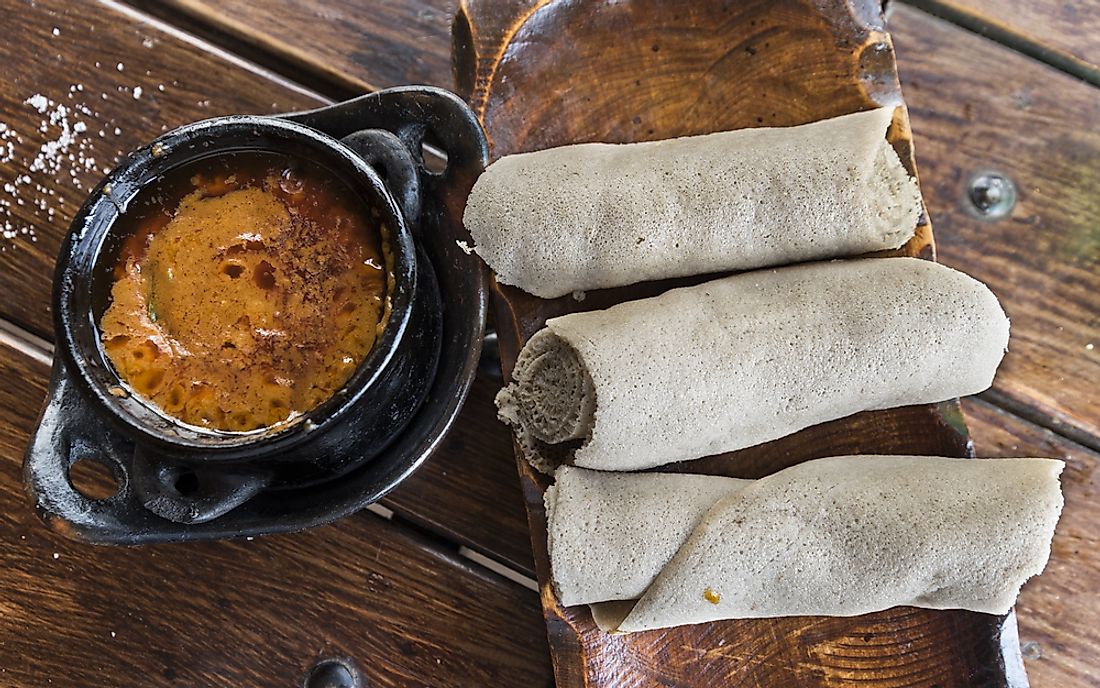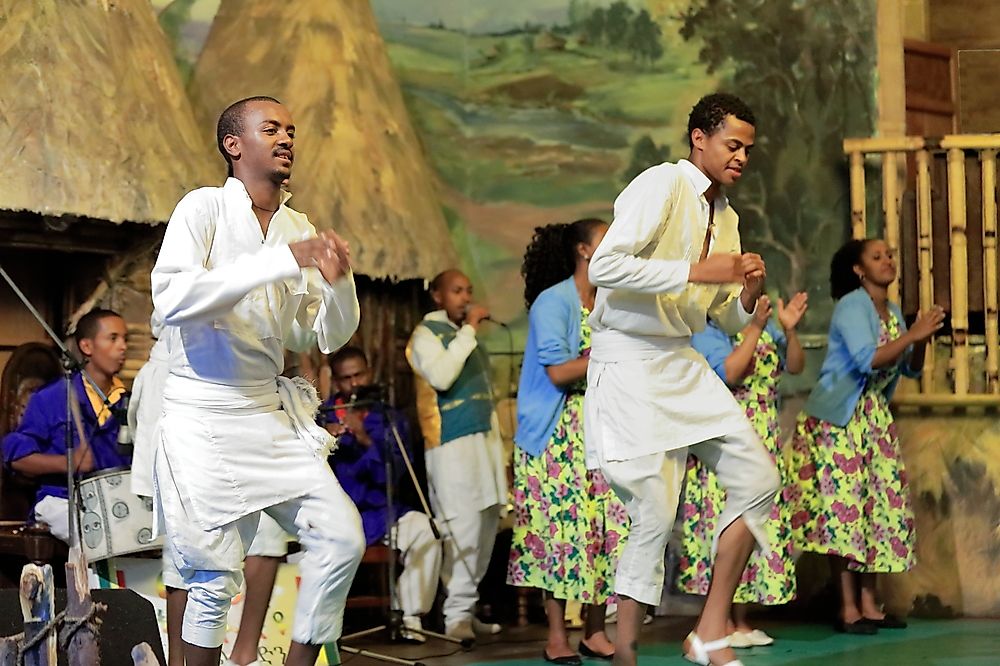The Culture Of Ethiopia

The northeastern African country of Ethiopia hosts a population of around 108,386,391 inhabitants. Ethiopia is home to people belonging to a great diversity of ethnic groups like the Oromo (34.4%), Amara (27%), Somali (6.2%), Tigray (6.1%), and others. Amharic is Ethiopia’s official national language. Oromo, Somali and Tigrinya are the official working languages of the Ethiopian states of Oromiya, Sumale, and Tigray, respectively. Christianity is the religion of the majority in Ethiopia. 43.5% of the population adheres to Ethiopian Orthodox Christianity while 18.5% of the Ethiopians are Protestant Christians. A significant section of Ethiopia’s population (33.9%) adhere to Islam. Catholics account for only 0.7% of the population. 2.7% of the country's residents follow their indigenous traditional religions.
6. Ethiopian Cuisine

Ethiopian cuisine is influenced by the cuisines of its various ethnic cultures and that of the country’s neighbors. The most common meal is the wat served with injera. The wat is a thick, spicy stew prepared with vegetables or meat. The Doro wat is another variant of the wat made with chicken and served with hard-boiled eggs. The injera is a large sourdough flatbread that is made out of fermented teff flour. Pieces of the injera are held in the right hand to scoop up the side dishes and entrees. Pork and seafood (with the exception of fish) are usually left out of Ethiopian cuisine due to the religious beliefs prevalent in the country. Several days of fasting are observed by the Orthodox Ethiopians Christians. During such days, meat and dairy are left out of food. The berbere, a spicy mix of powdered chili pepper and other spices, is often added to the Ethiopian dishes. The niter kibbeh, a type of clarified butter, is also commonly used. A popular Ethiopian breakfast dish is the Kinche which is made from cracked wheat, barley, oats, or a mixture of these ingredients that are boiled in water or milk. Spiced butter is added to the dish for flavoring. Atmet, an oat and barley-flour based drink with sugar, water, and clarified butter is a popular non-alcoholic beverage consumed in Ethiopia. Coffee and tea are also consumed widely. Some of the alcoholic drinks include tella (a homebrewed beer) and tej (a honey wine).
5. Clothing In Ethiopia
The varied climate of Ethiopia influences the dressing styles of its people. In the highland regions, cooler temperatures necessitate heavier clothing like wraparound blankets. In the lowlands, light cotton outfits are worn by the people to combat the summer heat. Some similarities are, however, observed in the clothing style of Ethiopians. Their clothes are almost entirely made of woven cotton. Men wear cotton pants and a white-collared, knee-length shirt. The women usually wear long white dresses of ankle-length with some colors above the lower hem. The dresses are called habesha kemis. Jewelry is worn to complete the look. Women, both Muslim and Christian, usually cover their head with a piece of cloth called sash. It is tied to the neck. A shawl called netela is worn by both men and women. It is draped in different styles depending on the occasion. While these traditional dresses are worn in everyday lives by the Ethiopians in rural areas, those in the cities wear Western-style clothing on a day-to-day basis. Traditional clothing is adorned by them on special occasions.
4. Literature And The Arts
The earliest Ethiopian literary works are in Geʿez and are mostly Christian religious writings. Between the 7th and 13th centuries, political instability in the region led to a suppression of the literary scene. In the 13th century, following the establishment of the Solomonid dynasty, the Geʿez literature was revived. The published works produced during this time also had religious themes. Between the 16th and the 18th centuries, Amharic written literature was also published in Ethiopia. Modern, contemporary literary works came to the scene from 19th century onwards. Christian paintings and stone reliefs are the earliest forms of Ethiopian art. Sculpting and wood carving are popular in the lowlands.
3. Performance Arts In Ethiopia

The music and dance heritage of Ethiopia reflects the diversity of cultures residing in the country. The music is generally less rhythmic and more reed and string-based than that in other parts of Africa. Some of the common traditional musical instruments used to produce Ethiopian music are the krar (a six-stringed lyre), negarit (a kettle drum), washint (a simple flute), etc. In the urban areas, hip-hop, jazz, pop, and other forms of contemporary music are more popular, especially among the urban youth of the country.
2. Sport In Ethiopia
Ethiopia is most well known for its success in athletics, especially in running. Football is also a popular sport in the country. The national football team of Ethiopia won the 1962 African Cup of Nations. Basketball is played by a large number of Ethiopians. Stick fighting is one of the most popular traditional Ethiopian games.
1. Life In An Ethiopian Society
Traditionally, Ethiopian men have enjoyed greater authority and status in society than women. Men are involved in carrying out the labor-intensive tasks like plowing, harvesting, herding, construction of homes, trading of goods, etc. Women are responsible for managing the household work and for children. The traditional gender roles have got somewhat blurred in modern-day Ethiopia, especially in the urban areas. Many women now work outside the home. However, even working women are expected to participate in domestic activities while men usually spend their free time socializing outside the home.
Marriages are mostly arranged, especially in rural areas. The groom’s family often provides a dowry to the bride’s family in the form of money, livestock, etc. Large feasts are held to celebrate the marriage and the ceremonies are held according to the customs of the ethnic group to which the couple belongs.
Traditional families in Ethiopia are usually extended in nature with the eldest male heading the household. Generally, men are the main decision-makers in Ethiopian families. They control the economy of the household and distribute the money needed to run the family. The father is seen as an authority figure in the family. Often, three to four generations reside in one household where the elderly generations are taken care of by their children. In urban areas, nuclear families are on the rise.
Inheritance is usually patrilineal in nature and sons inherit more valuable properties and other items than daughters. Children are raised by the mother and other female members of the extended family including elder female siblings.
Education is often more accessible to boys than girls as the traditional Ethiopian society believe that girls are less competent and that education is wasted on them.
Elderly are treated with great respect in a traditional Ethiopian society. Greetings are elaborate and include kissing on cheeks and exchange of other pleasantries. Hands must be washed before meals as most meals are had with hands. Guests are first served and it is customary for the guests to initiate the eating.











